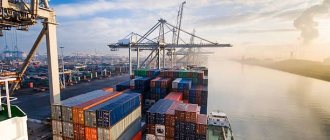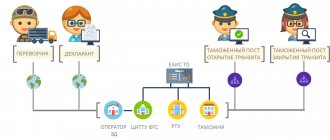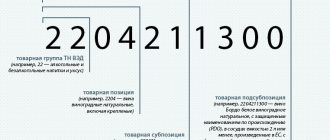According to statistics for 2021, Russian entrepreneurs received the largest fines for failure to comply with the customs clearance procedure for goods - an average of 8.4 million rubles. Such sanctions, of course, come for cases, for example, for deception in a declaration in order not to pay VAT or to reduce the amount of duty. But sometimes importers suffer unknowingly.
Let's say a person buys phone cases in China. He has been working with one supplier for two years, everyone is happy with everything, and the seller decides to surprise his partner - in addition to the batch of covers, he puts a dozen protective glasses in the box. There are no documents for the gift, the importer does not know about it and does not reflect it in the declaration. The inspector decides to inspect the cargo and finds unaccounted for products there. The unsuspecting entrepreneur will have to pay from 50% to 200% of the cost of the glass for Uncle Lee’s good intentions. Perhaps they will also be confiscated.
There are such nuances in the import process - a wagon and a small cart. When you start to delve into it, it seems that this is all too complicated and definitely beyond the capabilities of an ordinary entrepreneur without a honors diploma from an economics university. Calm down, it only seems! We have prepared a detailed guide that will help you easily bypass all the pitfalls laid out on the path of a novice importer.
If you previously traded only domestic goods or purchased imported products through an intermediary, and now you have decided to start purchasing goods abroad yourself, be sure to read this article. From it you will learn:
- What permits do you need to obtain?
- What documents are needed to import goods to Russia?
- How to pass currency control when paying for goods
- How does customs clearance of goods occur?
- How much will you have to pay for importing products?
- Import of goods: what problems arise most often
- How does the import VAT refund work?
- What to remember for a novice importer
We assume that you have already chosen the product, found a supplier and agreed on the price. We will talk about the import of clothing, stationery, equipment, toys and other non-food products. To import products, you need to go through a lengthy, expensive certification procedure; that’s a different story.
How to import goods to Russia: necessary permits
Before concluding an agreement with a supplier, find out what certificates and declarations need to be issued to import goods into the country. The list of permissions depends on what you will import. You will find information by studying the relevant regulations of the Customs Union - the most complete selection of them is available on.
To obtain a declaration of conformity, without which it will not be possible to import goods into the country, you need to test product samples in a specialized laboratory. Be sure to place an order for product samples with an individual entrepreneur or legal entity that will later import the goods into the Russian Federation.
If the goods are small in size, you can do without declaring them at customs. But it is necessary to place an order with the future importer, so that there is confirmation of the import of the sample into the country.
There are companies that can obtain permits for goods instead of you. For their services they charge on average from 18,000 to 50,000, if the product is problematic, then more. Be sure to ask the intermediary which laboratory will examine the samples and check through whether it has the right to work with the product group you need.
If the product is subject to technical regulations, then its packaging, invoice and packing list must bear the EAC marking (abbreviation for Eurasian Conformity). It confirms that the product has passed all necessary certification procedures and complies with safety standards.
This is what the mandatory labeling of a certified product looks like.
Forms of influence
International parcels The following can be used as a passenger customs declaration:
A registered IPO in the country of departure is assigned a unique 13-digit tracking number, by which you can control the movement of the IPO from sender to recipient, using the tracking services of the national postal operators of these countries or independent tracking services.
International postal tracking
Using the tool (implemented in the form of an Excel document) published on the UPU website, you can check the correctness of the track number, as well as calculate the verification code using the known eight-digit IPO number.
Tracking international postal items Accordingly, the records in the tracking systems will be of a similar nature and reflect the same stages of the passage of IPO from the sender to the recipient.
If, when tracking, the future recipient sees the “export” status, he needs to be patient. This is one of the most time-consuming processes when a postal item is transported from one country to another - from the sender to the recipient. Air transportation may be involved, but most often delivery is carried out by land.
Purchasing goods abroad: what documents are needed
Minimum package of documents for trouble-free import of products into Russia:
- agreement with the supplier,
- invoice,
- transport document,
- packing list.
They will be needed twice: at the bank, when paying for the delivery, and at customs, to draw up a declaration. Bank or customs officials may request additional documents: payment orders, price lists, specifications, etc., and you will have to provide them.
It is better to have the original contract - it will be useful if you decide to sue an unscrupulous supplier or take out a loan for goods.
Let's figure out what is contained in each of the required documents and how it should be drawn up.
Contract (agreement)
It must include:
- What products are you purchasing (with a detailed description of technical characteristics and quality criteria).
- How much does a unit of goods cost and what is the cost of the entire contract.
- Within what time frame must you pay for the shipment, and the seller must confirm receipt of the money?
- In what currency are payments made?
- Delivery terms according to Incoterms. is a set of different types of delivery conditions issued by the International Chamber of Commerce. It is needed so that participants in transactions from different countries interpret the text of the contract in the same way. Delivery conditions are hidden behind abbreviations. For example, FCA means that the seller is only responsible for shipping the goods and clearing customs in their country, and the rest falls on the buyer. DDP is an option in which almost all obligations for the delivery and processing of goods are assumed by the seller, and the buyer only has to unload the car on site.
- How should the product be packaged? The packaging can be anything, it is a matter of your agreement. But if the requirements are not specified in the contract, the seller will act at his own discretion. For example, it will send products in bulk in a container, which is why part of the batch will be damaged in transit.
- What documents must the seller provide along with the goods?
- How long does it take for the seller to notify you about the shipment of the goods after payment?
- What responsibility do the parties bear for violation of the terms of the contract and how are disputes resolved?
- How the parties act in the event of force majeure. An example from the recent past: in February 2021, some suppliers from China suspended deliveries due to the pandemic, but at the same time demanded full payment from buyers. It is important to stipulate such points in the contract so as not to be left without money or goods.
Explanation of the most common delivery options according to Incoterms 2020.
Contracts with suppliers from other countries are drawn up in two languages, most often Russian and English. We recommend not to be content with templates from the Internet, but to involve a lawyer and a specialized translator, especially if we are talking about large quantities and large amounts.
Invoice (account)
The invoice is generated by the seller. It must indicate:
- The names of both companies: yours and the seller.
- Number of units of goods in a batch.
- Cost of one unit.
- Total delivery price.
- Delivery terms according to Incoterms.
- Details of the parties.
After receiving the invoice, it is important to make sure that the details in the contract and the invoice match. Discrepancies may raise questions from the bank and customs.
Example of an invoice. The text EXW Guanzhou in the highlighted line means that the buyer must independently organize the shipment of the goods from the supplier's warehouse in Guangzhou (China).
Transport document
A document generated by the seller or carrier confirms that the shipping company has accepted the shipment from the supplier to deliver it to you. The type of document depends on how the cargo is delivered:
- For vehicles - international consignment note (CMR).
- For air transport - air waybill (AWB).
- For a train, an international waybill (SMGS).
- For a ship - Bill of landing.
If goods along the way are reloaded from one transport to another, for example, transported first by ship and then by train, a separate document is needed for each section of the route.
Packing list
In it, the supplier indicates:
- number of units of goods in the batch;
- cargo weight with and without packaging;
- type of packaging;
- cargo volume;
- number of cargo places.
The carrier uses this information to calculate shipping costs. A packing list is also useful if your goods are traveling as part of a consolidated cargo - it will help prevent confusion in the warehouse.
Example of a packing slip. It contains the most important information: the number of packages, their type, weight with and without packaging, volume.
Labeling of imported goods: categories of HS
First, let’s recall the codes of product groups that need to be labeled in 2021. We decided to present to your attention not only “bare numbers”, but also explanations for them.
Fur products - HS codes: 4303 10 901—4303 10 908
Fur coats are identified by KIZ - control and identification marks. This is an adhesive, sew-in or overlay label with a Data Matrix and a radio frequency chip - RFID tag. Products of several categories, including clothing, are microchipped:
- made entirely of natural fur;
- lined with natural fur;
- with fur attached to the outside, but not as a trim.
There is an exception: the group coded 4303 10 907 0. This is children's outerwear made of sheepskin, hare or rabbit fur, and the child's height should not exceed 164 cm and chest circumference - 84 cm.
Outerwear is sometimes decorated with fur trim. Such wardrobe items do not need to be microchipped, for example, a coat with mink fur cuffs or a parka jacket with a fox collar. But you need to label them Data Matrix - more on that below.
Not chipped:
- bags, backpacks, suitcases,
- hats, gloves and mittens;
- toys;
- sporting goods.
Shoes are also not chipped - they are also marked with Data Matrix.
Tobacco products - HS code: 2402
Obviously, all “traditional” cigarettes are labeled. There is a nuance with alternative “tobacco”. Only some products fall under category 2402:
- cigarillos;
- cigars and cheroots (with cut ends);
- bidi - thin Asian cigarettes;
- Kretek are cigarettes made from a mixture of tobacco, spices and clove leaves.
At one time, the CRPT, announcing the start of mandatory labeling of alternative tobacco (including, of course, imported goods), presented a list that included all its types, not only cigarettes and cigars made from it. And this is no longer 2402, but 2403, that is, tobacco itself:
- for hookah - 2403 11 000 00;
- smoking, pipe - 2403 19 100 0;
- chewing and snorting - 2403 99 100 0.
Imported light industry products - clothing, underwear and shoes - are also subject to mandatory labeling.
Note! After the release of the resolution on extending the deadlines for labeling balances, entrepreneurs are required to indicate the 10-digit HS code when describing balances on the ChZ website.
Blouses for women and girls - HS code 6106
This is knitwear made manually or industrially from cotton, chemical fiber or textile materials. Please note: T-shirts, T-shirts and sweatshirts, for example, sweatshirts or hoodies (they are also sometimes called body shirts) belong to category 6109. They do not need to be marked yet.
Outerwear for people of any gender and age - HS codes 6201—6202
This group of light industry products includes:
- Coat and short coat.
- Capes and cloaks.
- Jackets, Alaska and parkas, including ski parkas.
- Windbreakers, storm jackets.
An exception is outerwear made from faux fur (4304).
Leather clothing - HS 4203 10,000
The product group includes wardrobe items made of natural or composite leather, including workwear. The exception is accessories (belts, wallets, bags and briefcases) and hats.
Linen - HS code 6302
We have made a table for underwear to make the product list easier to understand:
| Lingerie category | Explanations |
| Bed linen | Pillowcases, sheets, duvet covers and mattress covers |
| Dining room | Tablecloths and runners, woven napkins, textile coasters and mats |
| Kitchen | Dish and tea towels |
| Dressing | Towels: for hands, face and body, bath and beach, gloves and bathing sheets |
Pillows, blankets and mattresses do not need to be marked, nor do kitchen aprons.
Footwear - HS code 6401—6405
With shoe products everything is simple - they all need to be labeled.
Perfumery - HS code 3303 00
Perfume and eau de toilette need to be labeled. Exceptions are stick deodorants, samples and exhibition samples.
Photographic equipment - HS code 9006
The category of labeled photographic products included:
- cameras;
- cameras;
- flashes (stationary pulsed photolights and studio modules);
- flash lamps (portable pulsed light sources, including camera components).
The exception is movie cameras (9006 91 000 0, 9006 99 000 0).
Subscribe to our channel in Yandex Zen - Online Cashier! Be the first to receive the hottest news and life hacks!
New pneumatic rubber tires - HS codes
These include tires:
- for passenger cars - 4011 10 000 3, 4011 10 000 9;
- for buses and freight vehicles (TC) with engines - 4011 20 100 0, 4011 20 900 0;
- for motorcycles - 4011 40 000 0;
- for forestry and agricultural transport - 4011 70 000 0;
- for construction equipment and vehicles used in mining - 4011 80 000 0;
- other - 4011 90 000 0.
The “Other” product group raises the most questions. It included all the other tires, including tubeless ones, for specialized equipment:
- garden carts;
- auto-, wheeled, forklifts;
- tractors;
- heavy vehicles;
- baby strollers;
Even tires for manual (for example, country) motor cultivators were included in the category.
Subscriber support for working with markings for 3 months.
4,500 ₽ Add to favorites
4 500₽https://online-kassa.ru/kupit/abonentskoe-soprovozhdenie-po-rabote-s-markirovkoj-na-3-mes/
OrderMore details In stock
Marking kit
48,699 ₽ Add to favorites
48 699₽https://online-kassa.ru/kupit/komplekt-dlya-markirovki/
OrderMore details In stock
- We recommend!
1 review
Turnkey product labeling
11,000 ₽ Add to favorites
11 000₽
https://online-kassa.ru/kupit/markirovka-tovarov/
OrderMore details In stock
Purchasing goods abroad: how to pay for delivery
To transfer money to foreign suppliers, you need to open a foreign currency account in a Russian bank. Read our article about what documents are needed for this and how much the service costs.
Banks carefully check foreign exchange transactions to prevent illegal withdrawal of funds abroad. This check is called currency control, it is carried out in relation to each transaction.
To transfer an amount that does not exceed 200,000 rubles in equivalent, as a rule, it is enough to indicate. If the amount is larger, you will have to collect documents according to the list that will be provided to you by the employees of the currency control department. Transactions worth more than 3 million rubles are especially carefully controlled - banks register them and take control: they monitor the timing of delivery of goods and transfer of money.
If changes are made to the contract that is registered with the bank, you must notify the bank about this within 15 working days and send an additional agreement. For violating the deadlines, the following fines apply: for an individual entrepreneur or legal entity - in the amount of 40,000 to 50,000 rubles, for an official - in the amount of 4,000 - 5,000 rubles.
Post office
The long-awaited status “arrival at the post office” means that the recipient can, without even waiting for the postman with a notification, contact directly the post office indicated in the status and receive his parcel. Other phrases may also be used in this message. For example: “Export of international mail from Russia. Arrival at the place of delivery." Ideally, delivery of the notice by the postman should be made on the same day, but more often it happens differently.
By the way, if you received the status “abandoned place of international exchange” from the Russian Post, then you do not need to wait more than ten days, since this is already a clear violation of the delivery time. Feel free to call and complain. Postal workers are required to respond to such a call. The parcel is searched for and a notice of its arrival at the department is immediately issued. And they give the notice to the postman. It's good if all the worries are over. Because there are also unsuccessful delivery attempts if the postal operator has to report this in the next status. Moreover, the specific reason for non-delivery is never displayed.
How to import goods to Russia: customs clearance procedure
All cargo arriving in Russia from other countries first ends up in temporary storage warehouses. They are located in ports, airports, container terminals, border checkpoints, and railway stations. You will have to pay for a consignment of goods to stay in a temporary storage warehouse - from 8,000 to 18,000 rubles for 2 days (depending on the warehouse). Loading, unloading, sorting and other services are paid additionally.
Extract from the price list for the services of a temporary storage warehouse located in Pskov.
Warehouse employees submit a report to customs stating that they have accepted the goods. After this, the process of customs clearance or, more simply put, customs clearance begins. You can do it yourself or contact a specialized company that will process the cargo for 15,000 - 25,000. If you decide to act through a broker, make sure that it is included in. Presence on the list means that the company operates officially.
If you arrange the goods yourself, you don’t have to go anywhere - you need to. No later than the end of the working day following the submission of the declaration, customs must release the goods, provided that all requirements are met. Otherwise, you will receive a refusal with a description of the reasons.
If a certificate of conformity has been issued for the product, customs may request a test report and a document confirming the import into the country of the samples that the laboratory studied.
Customs is there
Export of international mail - what does it mean? Expert's answer The parcel was transferred to the Federal Customs Service (FCS) and is processed there, simultaneously going through a rather long cycle of functions: processing, customs control, clearance. All postal containers receive customs transit procedures and are then sorted into areas and types of shipments.










